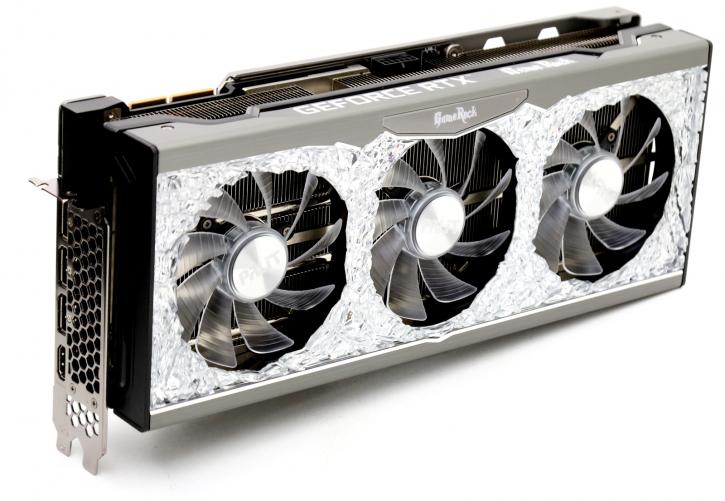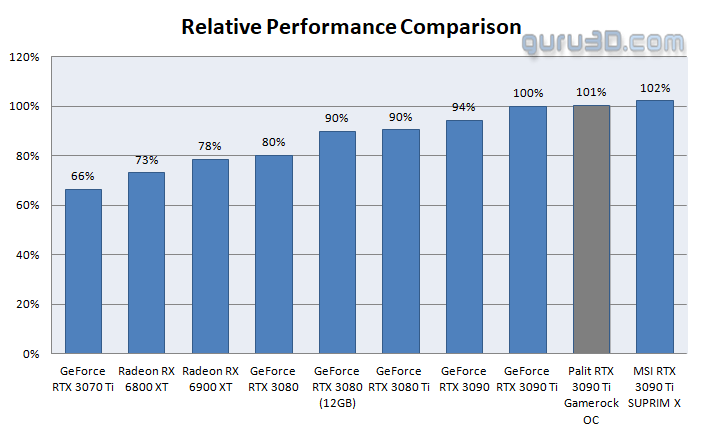Final words and conclusion
Performance
Gaming performance, as well as rendering quality, are important considerations. Of all, the GeForce RTX 3090 Ti is a device that does not have to make sense, and hence cannot disappoint in that regard, albeit we believe the RTX 3070 Ti / 3080 clearly delivers better value for money on a far better energy budget. Despite the fact that the device's price, performance, and power consumption are all out of the usual threshold, there's something fascinating about it that's difficult to nail down, so it's back to the good old x-factor once again. Essentially, this is a device that does not need to make sense and hence cannot disappoint, but we believe the RTX 3080 series provides better value for money. As previously said, you must feed the card what it requires, preferably a GPU-intensive game in Ultra HD. NVIDIA says that this card is capable of running games at 8K resolution; however, we cannot verify this objectively. At Full HD, you'll frequently encounter bottlenecks and CPU constraints. However, even there, the performance boost in some games with good programming and the appropriate API (DX12/ASYNC computation) is amazing. The venerable rasterizer engine smashes straight over the extreme performance barrier. All of this is possible because to the 10+ K Shading processors. We can confidently declare that this is a real Ultra HD capable graphics card, as it should be at this price point. However, whether you use regular rendering or games that support ray tracing and DLSS management all come together in that UHD resolution. An updated generation (more powerful) Ray tracing and Tensor cores have been added to the RTX 30 series. Therefore, do not be misled by the real RT and Tensor core counts. They're positioned close to the rendering engine, which means they've become more efficient, which shows. When using an RTX 2080 with Port Royale, we can get over 30 frames per second. At well over 60 frames per second, the RTX 3090 Ti greatly doubles that. Tensor cores are more difficult to quantify, but given what we have observed thus far, everything appears to be in balance. Overall, the GeForce RTX 3080 makes sense starting at a Quad HD resolution (2560x1440), whereas the RTX 3090 and Ti make sense starting at an Ultra HD resolution (3840x2160). As is typically the case when comparing apples to oranges, performance statistics differ slightly between architectures due to each architecture's inherent benefits and weaknesses in certain game render workloads.
Cooling & noise levels
Palit has a massive cooler, and it can keep up with all of the watts of heat coming from the 3090 Ti. While the temperatures are in line, the acoustics, on the other hand, are consequential. You'll close in at a TGP of 465 Watt for this product under full load, and that directly relates to the output heat of your product, there is heaps of it ditched inside your chassis. Despite the fact that we reached 41-42 dBA under very stressful conditions, this is considered a reasonably acoustic level. Under heavy load situations, anticipate the card to reach temperatures in the 75-80 degree Celsius range, depending on the amount of ventilation in your chassis (depending on the airflow in your chassis). Mind you that the DBA value might seem high, really it is comfortable to listen to.
Energy
Your heat production and energy consumption are always tightly tied to one another while you are using a (graphics) processor, and heat can be seen as a 1:1 condition, meaning that 100 Watts of (consumption) heat often equals 100 Watts of heat output. Thermal designs are built on this foundation. This card has a 465-watt TGP. Which is tottering for a graphics card in the year 2022, they are enormous quantities of energy, and we believe that these are values that should not be taken for granted. As a result, we are dissatisfied with the new energy consumption figures since they represent a trend that is outside of my comfort zone.
Coil whine
Detecting coil whine on this card was a hard thing (good). Graphics cards all make this in some form, especially in high framerates this can be perceived. In a closed chassis, that noise fades away in the background.
Pricing
NVIDIA is pricing the GeForce RTX 3090 Ti at USD 1999 and in the EU that's exclusive of VAT. It's excessive money for something to play PC games on. This product is so exclusive that it creates its own niche. This AIB card will get listed at €2250 with a similar number in USD. But if availability is low, we can easily see the prices hike to the sub-2500 EUR/USD marker.
Tweaking
We've been relatively modest with our overclock of this card, and at this money and TDP, you should be as well. Keep in mind that you already have a power budget of around 500 Watts. Our card has a power limitation, which means that you cannot increase power usage. Furthermore, voltage control was not yet in place. Finally, a +125 Mhz core offset took the card up to 2200 MHz depending on the game. You will, however, be more constrained due to the power restriction. The RAM could easily handle an additional +750 Mhz. And at double the data rate, it worked absolutely great at 22500 MHz (effective data rate). Overall, we were able to squeeze an extra 4 percent performance out of the card.
Conclusion
It is essential to realize that the GeForce RTX 3090 Ti provides odd performance levels at an unreasonable price while also using an excessive number in electricity. Regardless of how many superlatives we use, this still is an x-factor product, which implies that people are still gonna purchase these cards regardless of the price. Palit has created a captivating graphics card, both in terms of aesthetics and component choices for this hardware setup. For a suggested retail price of 1999 USD, the card is clearly a hard sell; for that money, you should seriously consider a 3080 / Ti at half the price.
It's an enchanting product—both in terms of gaming performance and, of course, rendering quality. My primary considerations are not performance, cooling, or even cost. This card uses close to 500 Watts of power, which is just too excessive for my taste. Many will disagree with me or will be unconcerned about energy use. For this card to make any sense, you must be gaming in Ultra HD or above. Regardless of me frowning on price and energy consumption; I do adore a good chunk of gear within a PC though It is important to ensure that you have adequate ventilation because the RTX 3090 Ti creates a significant amount of heat. Despite the fact that it is huge, it still appears to be of high quality. Keep in mind, however, that the card is quite strong if you give it the correct conditions, which include the highest resolutions, maximum picture quality settings, and GPU-intensive games, among other things. Compared to the competition it looks like Palit is in for challenging circumstances here. If acoustics are a concern for you, we can assure you, it ain't bad at all. This product will be at least as quick as an FE and most AIB partners as that performance differential is a few percent at best. As a product series, we feel it's priced too steep and consumes too much energy. As hardware aficionados, we're awed by the performance and the sheer fact that these x-factor products are even released. The release overall feels too costly and a little late with Hopper architecture just being announced though.
Sign up to receive a notification when we publish a new article.
Or go back to Guru3D's front page
- Hilbert, LOAD"*",8,1.



